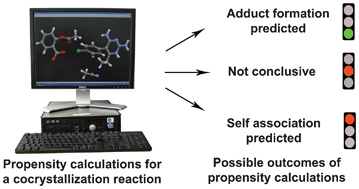We have previously reported on hydrogen bond propensity calculations for the potential formation of adducts between pyrimethamine and dicarboxylic acids. Here we extend the range of potential synthon interactions using a variety of potential coformers. Specifically calculations were performed to predict the possibility of the formation of molecular adducts, 1a–1h, between the anti-malarial drug pyrimethamine (1) and (a) carbamazepine, (b) theophylline, (c) aspirin, (d) α-ketoglutaric acid, (e) saccharin, (f) p-coumaric acid, (g) succinimide and (h) L-isoleucine. The bonds of highest propensity were predicted between 1 and coformers (b–h), indicating a high probability of formation of adducts between 1 and b–h. In contrast the bonds of highest propensity were between reactants and the solvent for the adduct 1a, indicating either a high probability of the reactants crystallizing as solvates or incorporation of solvent into the adduct lattice. Experimental results agreed with the propensity calculations with the formation of a solvated cocrystal (1a·CH3OH). The successful application of hydrogen bond propensity calculations to the prediction of likely outcomes of these cocrystallization reactions suggests that this may be a useful tool in designing more targeted screening experiments.

